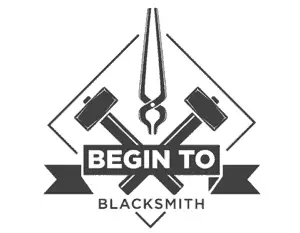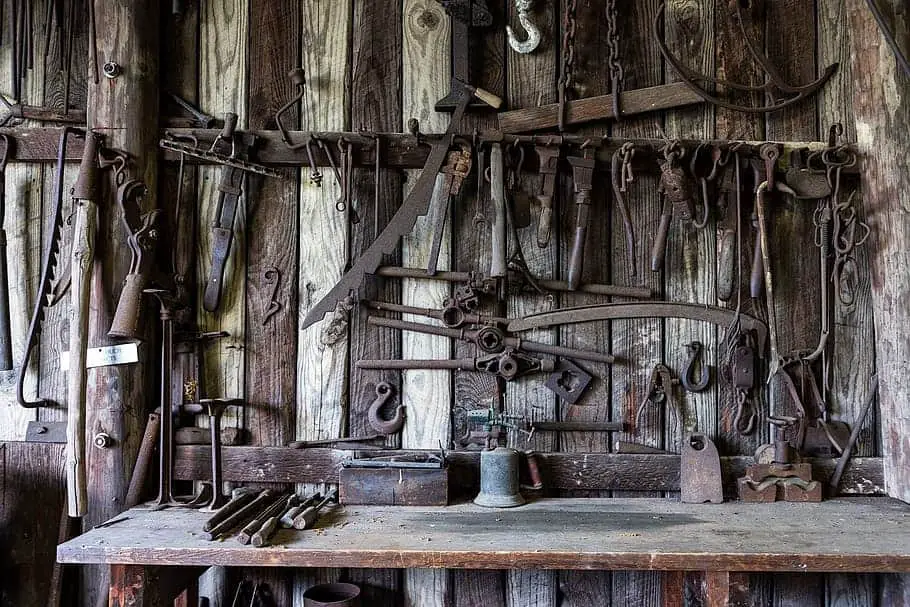One thing that I love about blacksmithing is just how flexible and adaptable it is to whatever your lifestyle or situation is. Do you have lots of cash to spend? Great! There are thousand-dollar forges and expensive projects that you can grow crazy with.
However, since most people don’t have that kind of disposable cash (unfortunately), the good news is you don’t need to spend that much money on getting started as a blacksmith.
In a previous article I’ve written called, “How to Start Blacksmithing at Home for Less Than $200” (check it out here), I go into exactly what you need to get started as a beginner blacksmith, as well as how to make some DIY modifications to save you on cash.
In this article, I want to go over in a bit more detail the exact materials, supplies, and nifty things to have on hand if you want to spend time blacksmithing.
This includes things such as;
-What metal to buy
-Where to buy it and how much it costs
-Your fuel (gas or coal)
-Waxes and finishes
-Chisels
-Punches
As for the absolute basics, I assume you’ve already gotten your hands on an anvil, a hammer, a forge, and other, basic blacksmithing equipment you’ll need to get started.
I’ve written articles on exactly what equipment you need to begin, but as I mentioned, this article will mainly focus on the actual materials and supplies that blacksmiths tend to require and use up on a consistent basis.
Let’s get started.
Understanding Your Metal
When it comes to what metal you want to use, this is often the biggest question beginner blacksmiths ask. My answer is usually that what you want to use depends on the quality and seriousness of your project or work.
If you’re just playing around for practice or simply just smithing something for the fun of it, then you can feel free to use whatever pieces of scrap metal you have lying around.
This is good if you want to save yourself some money as well. Often time, a stop by your local scrapyard will save you tons of cash that you’d otherwise spend on buying up some steel. You might often be able to get a bunch of metal for free, simply by asking nicely.
However, if you’re trying to make something of a more serious nature, then you’re really going to need to invest in some high-quality steel. The reason is that you have no idea exactly what the carbon content is for a piece of random scrap metal you have. This, in turn, affects the qualities and properties of the metal.
In other words, how tactile it is, how fragile or brittle it’ll be when heated/cooled, as well as the exact melting point are all different depending on the quite of material you’re using.
Higher carbon content metals, such as cast iron (which has a 2% carbon content), is almost totally brittle and useless for blacksmiths. On the other hand, low carbon content metals (such as wrought iron, where the carbon percentage is less than 0.25%), have the opposite problem. They can’t be smelted.
The perfect mix for blacksmiths is between 0.5% and 2.0% carbon content, in my opinion. This is exactly where you’ll get the best combination of smeltability, malleability when under heat, as well as not being too brittle after your metal cools down.
Of course, getting high-quality steel for your work isn’t going to be cheap. However, if you are trying to make something serious or sell it somewhere to earn a side income, using high-quality materials is essential.
Your Forge’s Fuel
You’re also going to need some fuel in order to keep your forge running. Once again, this depend largely on the type of forge you’ve already gotten for yourself.
For beginner blacksmiths looking to get started, I typically recommend using a gas forge. The upside to gas forges is that they are easier to use and don’t require a lot of technical understanding.
Best of all, gas forges can be incredibly cheap. I’ve written an article covering the best types of forges for beginners, as well as some of the best models out there that go for less than $200!
As you’d expect, gas forges use propane gas, so if you’re going to get one, you will also need to stock up on some regular propane you can find in most hardware stores or gas stations.
On the other hand, however, you could get a coal forge. These tend to feel less “modern” and more “traditional,” in a sense. However, the downside is that coal forges, besides getting very messy, can also be quite hard for a beginner to use.
Whereas a gas forge can simply be turned on and set to a specific heat temperature, using a coal forge means you’re going to need to manually watch your forge’s temperature and judge for yourself whether it’s cooling down too much.
At the same time, coal forges can be a lot more expensive as well. Whereas the most expensive gas forges I see go for around $400, I’ve seen fancy coal forges range up to $1,000 or more!
In terms of cost, coals and propane are more or less the same when you consider how quickly you will be using up both with their respective forge types.
Lastly, of course, there’s always the classic wood forge. Simply lighting a fire with some wood underneath is another option for people to consider. It’s definitely the most traditional method of them all, but like I said, I don’t think it has the same reliability, simplicity, and effectiveness that a gas forge brings to the table.
Chisels and Punches
When most people think of what they need to get started as a beginner blacksmith, an anvil, hammer, and forge are typically the first things that come to mind.
However, there are a few other smaller, specialized supplies that blacksmiths will quickly need as well. Chisels and punches are two things that every blacksmithing should carry with them.
The difference is relatively simply. Chisels are used if you want to cut off a piece of metal regardless of whether it’s hot or cold. In the case of hot metals, chisels tend to be thinner and longer, whereas working with a cold, hardened metal, a shorter and thicker chisel is needed.
On the other hand, punches are quite similar to chisels, except they literally “punch” a hole through your metal. This is essential if you’re trying to do so something a bit more complex that needs multiple parts to be put together.
If you’re forging a knife, for example, you might need to punch a hole in your blade where the handle would be so you could install the actual grip material you’re going to use.
Without having a chisel or a punch on hand, you’re going to find yourself very limited by what you can and can’t do as a blacksmith.
Finishes
One thing that most blacksmiths will need to check out some time or another are finishes for your work.
Often times, when you finish your project, it’s going to look rather dull and unappealing. The solution is to apply a nice wax finish on your project in order for it to look more appealing, especially if you’re planning to sell what you’ve made online or in person.
However, even besides the appeal factor, there are a few other reasons why all blacksmiths should consider using finished on their work. For one, it actually smoothens your finished project. If you’ve made a knife or a blade, using a finish will make it that much nicer to touch. At the same time, finishes help prolong the longevity of your work. By applying a natural or a synthetic finish, you’ll protect your metal against corrosion, rust, and eventual degradation.
As for what kind of finish I’d recommend, there are a few out there on the market, and all are reasonably effective. This includes different types such as boiled linseed oil (sometimes mixed with turpentine), or something more industrial, such as black oxide. However, my favorite finish is the all-natural beeswax.
Used by traditional blacksmiths for centuries, beeswax is an excellent way to protect your metal from corrosion while also making it look nicer. If what you’ve made will be used in food prep, such as a kitchen knife or some cooking utensils, beeswax also works because its non-toxic. The same cannot be said about the other finishes you’ll find on the market out there.
You can check out which specific beeswax finish I recommend for beginner blacksmiths here.
Takeaways
A lot of people don’t spend a lot of time talking about the actual consumables and supplies blacksmiths need to do their work. It makes sense, especially since talking about beeswax finishes or the difference between a chisel for hot and cold metals isn’t all that exciting. However, it’s still something that needs to be said.
If you want to work on something in a serious capacity, make sure you have all the things listed above on hand. While having some metal and fuel for your forge is painfully obvious, keeping a reserve of beeswax or linseed oil finish might not be.
Begin to Blacksmith is a participant in the Amazon Services LLC Associates Program, an affiliate advertising program designed to provide a means for sites to earn advertising fees by advertising and linking to Amazon.com. I get commissions for purchases made through links in this post.

